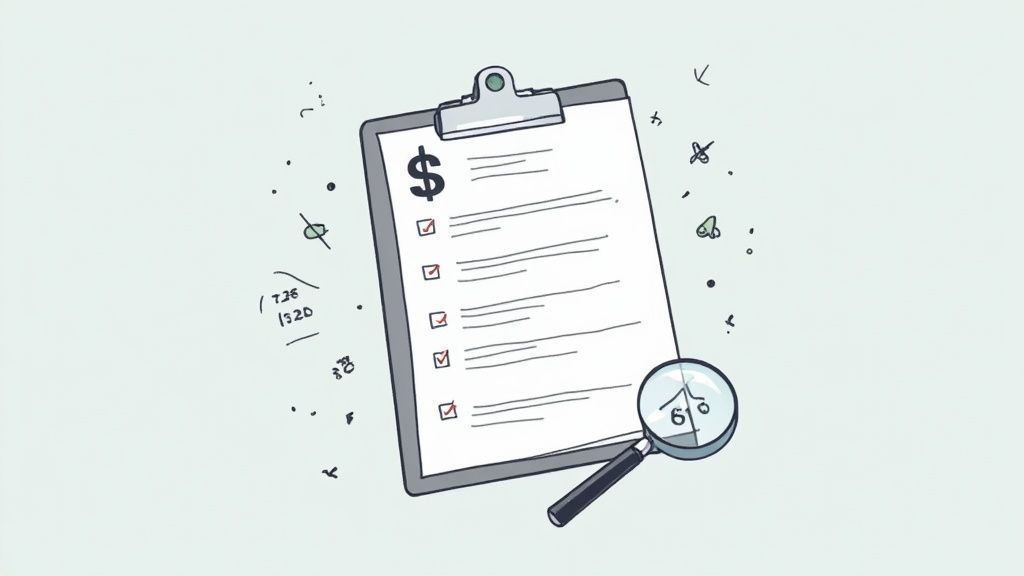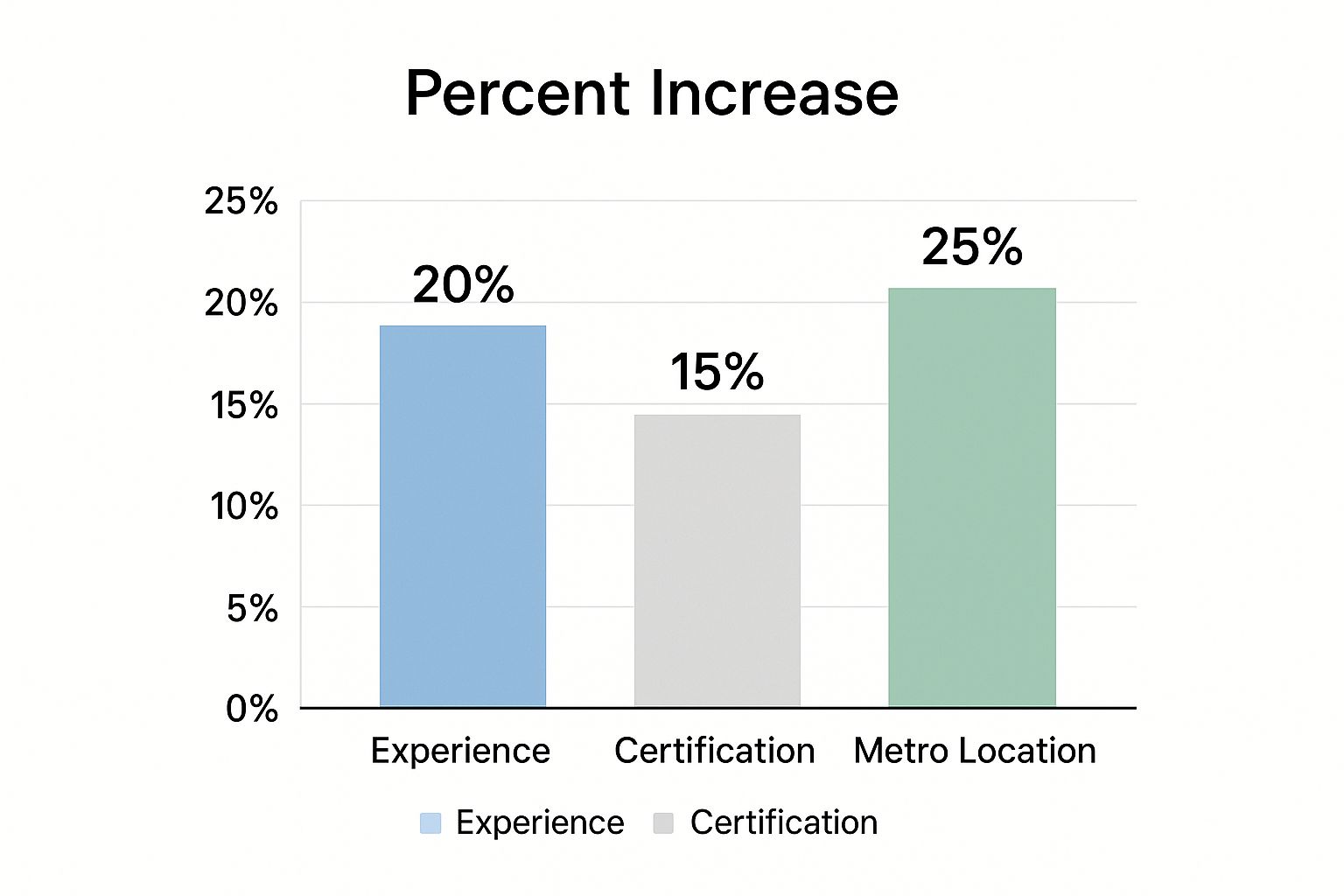
 17 minutes read
17 minutes read
So, you want to talk about paralegal hourly rates. Let’s cut through the noise and get straight to the point.
The number you see tossed around—that $33 per hour average—is what a paralegal gets paid. It's not what a law firm bills a client. The number that actually matters to your P&L, the billable rate, is a whole different beast. It can swing from a "wow, that's cheap" $45 an hour to a "did I read that right?" $125+ per hour.
And if you get it wrong, you’re either leaving money on the table or getting fleeced.

Trying to nail down the "right" paralegal hourly rate can feel like chasing a ghost. One report gives you a number, your buddy at another firm quotes another, and suddenly you’re lost in a spreadsheet of conflicting data. It’s confusing, and you’re not the first person to feel that way. I've been there.
Here’s the truth: there's no single magic number. This isn't some academic exercise; this figure hits your bottom line directly. Think of this as the founder-to-founder guide on navigating the terrain before you hire someone or, God forbid, restructure your client billing based on bad intel.
First things first: let's kill the confusion between what a paralegal earns and what a firm bills.
The average hourly pay for a paralegal in the U.S. has climbed to about $33, up from $29.31 in 2023. Fine, that’s your baseline cost. But it’s just the beginning of the story.
What clients see on the invoice is where the real action is. Billable rates often start around $45 for basic administrative stuff and can blast past $125 per hour for the heavy-lifting, like complex litigation support. If you want to dive into the data yourself, you can discover more insights about paralegal billing trends on clio.com.
Here’s a quick-and-dirty look at how rates usually map to the work.
Not all paralegal work is created equal, so why would you bill it that way? Below is a simplified breakdown. If your billing doesn't look something like this, you’re doing it wrong.
| Paralegal Task Type | Typical Billable Hourly Rate Range |
|---|---|
| Administrative & Clerical Tasks | $45 – $75 |
| Document Preparation & Review | $70 – $110 |
| Legal Research & Case Management | $90 – $125 |
| Specialized & Litigation Support | $100 – $150+ |
This table tells a simple story: the more specialized the work, the more you charge. The more brainpower required, the higher the rate.
So, what’s the takeaway for your firm?
Ultimately, finding affordable paralegal services isn't about chasing the lowest possible rate. It's about understanding the ROI on every dollar. Time to ditch the guesswork and make some informed decisions.
If you think every paralegal comes with the same price tag, you're setting yourself up for a world of pain. A paralegal isn't a commodity you pull off a shelf. Their hourly rate is a complex cocktail of value, scarcity, and a dozen other factors you ignore at your own peril.
It’s tempting to fixate on a single dollar amount, but that number is telling you a story. It reflects a unique mix of skills, market pressures, and specialized knowledge. Understand this, and you stop comparing apples to oranges and start making strategic hires that actually grow your firm.
So, let's break down the "Big Three" that really move the needle.
This one seems obvious, but people underestimate its impact. A paralegal with a decade of trial prep under their belt is a different species than someone fresh out of a certification program. You're not just paying for time served; you’re paying for battles won and mistakes already made on someone else's dime.
Basically, a higher rate buys you proactive problem-solving instead of reactive task-checking.
Ever see "NALA Certified Paralegal" and wonder if it's just resume fluff? It's not. These certifications are a signal of commitment and validated expertise. It means they’ve passed tough exams and are keeping up with continuing education. It means they know their stuff.

A paralegal with an advanced certification in e-discovery isn't just another body in a chair; they're your firm's shield against drowning in data or, worse, facing sanctions for mishandling it.
That credential justifies a higher hourly rate because it’s a direct investment in risk mitigation and efficiency. You're paying for a tested skillset, not just a claimed one.
This is where the rate swings get wild. An IP litigation paralegal in New York City is playing a different game—high cost, high stakes—and their rate will reflect that. That same role in Omaha? A totally different market reality.
And it’s not just where they work, but what they work on. A family law paralegal handling standard filings is a different animal than a corporate paralegal navigating M&A due diligence. The latter's work carries more financial weight and requires a deeper, more specialized knowledge base. Don't be shocked when their rates are 50% higher—you’re paying for specialized firepower, not just another pair of hands.
Alright, let's get down to brass tacks. If you think the paralegal you hire for a trademark filing should cost the same as one handling routine divorce paperwork, you’re in for a rude awakening. The market pays a premium for high-stakes knowledge, and that distinction is the difference between a profitable firm and a struggling one.
Why the huge gap? Complexity and demand. A screw-up in a patent filing could cost a client millions. An error in a real estate closing? A few thousand in damages, maybe. The rates reflect that risk.
Not all legal work is valued equally, and paralegal rates prove it. National data shows a clear trend: general admin support might bill out at $45–$60 per hour, but a sharp intellectual property paralegal can easily command $90–$125 per hour. That's more than double. For a reason.
Litigation paralegals—the masters of discovery deadlines and trial prep—usually land in the $75–$120 range. You can explore a detailed breakdown of these rates to see exactly where your needs fall.
Here’s a cheat sheet for what you should expect to pay:
To make it even clearer, this table breaks down how different legal fields stack up.
| Practice Area | Average Billable Rate Range (U.S.) | Key Skills Driving the Rate |
|---|---|---|
| Corporate/Transactional | $70 – $115 | Entity formation, due diligence, contract management, M&A support. |
| Litigation | $75 – $120 | E-discovery management, trial preparation, deposition summaries, case timeline management. |
| Intellectual Property (IP) | $90 – $125 | USPTO filings, patent/trademark prosecution, docketing, foreign filing coordination. |
| Family Law | $65 – $95 | Client communication, financial affidavit preparation, discovery requests, scheduling. |
| Real Estate | $60 – $100 | Title searches, closing document preparation, lease review, survey analysis. |
| Bankruptcy | $65 – $105 | Petition preparation, creditor matrix management, means testing, asset schedules. |
See the pattern? The more specialized and high-stakes the work, the more you pay. This isn't just about paying for tasks; it's about paying for expertise that shields your firm and clients from massive risk.
On top of the practice area, you have to account for geography. Trying to hire a paralegal in a major city with a Midwest budget is a great way to get laughed out of the room. Cost of living and market demand create huge rate disparities.

Don't get sticker shock when a paralegal in Los Angeles or D.C. quotes a rate that’s 25% higher than one in a smaller city. You're not just paying for their skills; you're paying for their zip code and the hyper-competitive market they’re in.
This chart drives the point home.

It’s crazy, right? Simply being in a major metro can add a bigger premium to a rate than years of experience. Keep that in mind so you don't make an offer so low you become a joke on the local paralegal forums.

Ah, the classic debate. Do you hire a full-time, in-house paralegal, or tap into the freelance market? It seems simple, but if you’re only looking at the hourly rate, you’re missing half the story. And the half you're missing is the expensive part.
This isn’t about comparing two numbers. It’s about the total cost of ownership for an employee versus the clean, simple cost of a contractor.
Let's be blunt: hiring an employee is expensive. It's way more than their salary. You’ve got benefits, payroll taxes, insurance, office space, equipment, software licenses… and the inevitable downtime when you’re paying a full salary for half the work.
A freelance paralegal, on the other hand, often has a higher hourly rate. But that rate is all-in. No benefits, no taxes, no paying them to surf the web when things are slow. You pay for work, period.
Let's do some back-of-the-napkin math.
You hire a great paralegal at $60,000 a year. On paper, that's about $29 per hour. A steal, right?
Not so fast, my friend. Let's add the real-world costs:
Suddenly, your $29/hour employee is really costing your firm closer to $40-$45 per hour. And that’s before you account for non-billable time.
This is where the math gets fun. A freelance paralegal quotes you $65 per hour. Your gut says that's way more expensive. But that’s a fully loaded cost. You aren't paying for their health insurance, their 401(k), or their vacation.

The real magic of a freelancer is paying for pure productivity. When your caseload is a roller coaster, a freelancer lets you scale up or down instantly without the financial drag of a salaried employee during the slow months.
Think about it. Need an e-discovery expert for a six-week project? Freelancer. Sudden overflow of real estate closings? Freelancer. This flexibility is where the real savings are hiding.
To see how this model completely changes the game, check out our guide on virtual paralegal rates. The obvious answer isn't always the right one, and sometimes paying a premium for on-demand expertise is the smartest financial move you can make.
Hiring a great paralegal is one thing. Actually turning their work into profit? That’s a whole different game. And if your billing strategy sucks, you might as well light a pile of money on fire.
This is about the mechanics of making money. It's about setting client-facing rates that reflect the immense value your paralegal provides while keeping your margins healthy. This is the stuff they conveniently forgot to teach in law school.

Setting your paralegal’s billable rate isn’t just picking a number. It’s a calculated move. A common rule of thumb is the "Rule of Three": you bill the client roughly three times what you pay your paralegal per hour.
So if you pay a paralegal $40 per hour, you’d bill them out at around $120. Why so high? That markup isn't pure profit. It covers their salary, your firm’s overhead (rent, software, that fancy espresso machine), and then your profit margin. Get this wrong, and your profit center becomes just another expense.
But a formula is just a start. You have to align the rate with the task. You can't bill $150 an hour for filing, but you're cheating yourself if you bill that low for complex legal research.
Let’s talk about the elephant in the room: ethical billing. The ABA has opinions, and you should listen. The main takeaway: you can only bill clients for substantive legal work performed by a paralegal.

Think of it this way: If an attorney could have ethically billed for the task, a paralegal probably can too. This includes legal research, drafting documents, and case management—not making photocopies or scheduling lunch.
Trying to pass off clerical work as billable paralegal time is a fast track to an ethics complaint and a pissed-off client. Just don't.
The final piece is explaining the paralegal line item on an invoice without triggering a panic attack. It’s all about framing. You’re not just charging for "paralegal time"; you’re showcasing efficiency.
Here’s the script: "We use our highly skilled paralegals for tasks like X and Y to keep your costs down. The alternative would be having an attorney do that same work at a significantly higher rate."
Boom. The paralegal isn't an extra cost—they're a cost-saving measure. This, combined with detailed billing entries, builds trust and kills sticker shock before it starts. To really nail this, you need to understand the principles of what is legal project management. It turns your paralegal from an expense into a strategic asset clients actually appreciate.
So, you’ve found a rockstar paralegal. Their resume is perfect, the interview was great, and you’re ready to make an offer. Then they hit you with their rate, and it’s… more than you budgeted for.
Don't panic. This isn't the end of the road; it's the start of the negotiation. Whether it's a full-timer or a freelancer, their first number is rarely their final number. Think of it less as haggling and more as a strategic conversation to find a rate that works for both of you.
There's a classic rule in negotiation: the first number dropped becomes the anchor. If they say they want $75 an hour, the entire conversation now revolves around that figure. Your job isn't to lowball them into submission but to gently reset that anchor.
Instead of a knee-jerk counteroffer, start by talking about your firm’s budget in the context of the role. Share the market data you’ve pulled for your specific city and practice area. This shows you’ve done your homework and shifts the focus from their wish list to what's competitive in the real world.

And remember to look beyond the hourly rate. The conversation should be about the total package. A candidate might take a slightly lower rate for a more flexible schedule, better benefits, or a chance to work on high-profile cases that build their resume.
Once they're on board, a new negotiation begins—this time with your clients. Smart clients read their bills, so be ready to justify the paralegal rate.
The key is to frame it around value, not hours. You aren't billing for "time"; you're billing for efficient, high-quality outcomes.
Here are two proven tactics:
This isn't about being defensive. It’s about confidently demonstrating that you made a smart, cost-effective decision on their behalf. Frame it that way, and the paralegal rate stops looking like an expense and starts looking like a sign of an efficient firm.
Alright, let's cut to the chase. Even when you think you've got this figured out, a few questions always pop up. We hear them from firms all the time. Here are the straight-up answers.
No. And if you try, you're asking for trouble. The ABA is crystal clear: you can only bill clients for substantive legal work done under an attorney's supervision. Think tasks that require actual legal knowledge—research, drafting, case management.
What you can't bill for is purely clerical work. Making copies, filing, or scheduling meetings is the cost of doing business, not billable time. It’s a rookie mistake that can wreck your firm's credibility. Don’t be that firm.
There's no sacred number, but a smart, profitable industry standard is to bill clients 2.5 to 3 times the freelance paralegal's direct cost. That might sound steep, but it's not all profit in your pocket.

Let’s say you pay a freelancer $40 per hour. A standard, justifiable bill rate would be $100 to $120 per hour. This covers your overhead, your time supervising their work, and then leaves a healthy profit margin. Go much lower, and you're basically working for free.
For the love of all that is holy, pay them hourly. Most paralegals are classified as non-exempt employees under the Fair Labor Standards Act (FLSA). This is a big deal. It means they are legally entitled to overtime for any hours worked over 40 in a week.
Paying an hourly wage makes tracking and calculating overtime clean and simple. Sure, you can put a paralegal on salary, but it means they have to meet very specific and tricky "duties tests" to be considered exempt. Unless you have a burning passion for navigating compliance headaches, stick with hourly. It's transparent, it's fair, and it keeps the Department of Labor off your back.
Stop drowning in resumes and start interviewing qualified candidates. HireParalegals delivers pre-vetted, remote legal talent to your firm in as little as 24 hours. Find your next paralegal today.